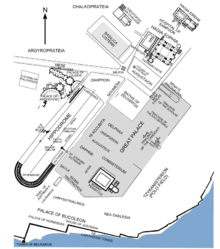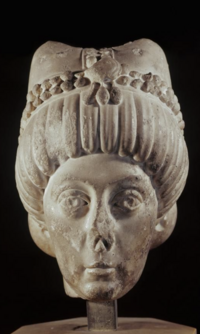Nika riots
This article needs additional citations for verification. (December 2021) |
| Nika riots | |||
|---|---|---|---|
 Site of the Hippodrome of Constantinople in Istanbul | |||
| Date | January 532 C.E. | ||
| Location | |||
| Caused by | See causes | ||
| Goals | Free demes' leaders, overthrow Justinian | ||
| Methods | Widespread rioting, property damage, murder, arson | ||
| Resulted in | Military action by imperial government leading to the escalation and militarization of the riots | ||
| Parties | |||
| |||
| Lead figures | |||
| |||
| Casualties | |||
| Death(s) | 30,000 rioters killed[1] | ||
The Nika riots (
Background
The Roman empire had well-developed associations, known as demes,[2] which supported the different factions (or teams) to which competitors in certain sporting events belonged, especially in chariot racing. There were initially four major factions in chariot racing, differentiated by the colour of the uniform in which they competed; the colours were also worn by their supporters. These were the Blues (Veneti), the Greens (Prasini), the Reds (Russati), and the Whites (Albati),[3] although by the 6th century the only teams with any influence were the Blues and Greens. Emperor Justinian I was a supporter of the Blues, although his support for the faction abated as he entered the early years of his reign, taking a more neutral stance as he looked to limit the power of the factions.[4] With rising tensions, one could even argue that striving for impartiality was a more dangerous policy to try and adopt.[4] However, Justinian's previous ardent support of the Blues made him seem less unbiased and contributed to his waning control of the capital leading up to 532.[5]
The demes had become a focus for various social and political issues for which the general Byzantine population lacked other forms of outlet.
In 531 some members of the Blues and Greens were arrested for murder in connection with deaths during rioting after a chariot race.[7] Relatively limited riots were not unknown at chariot races, similar to the football hooliganism that occasionally erupts after association football matches in modern times. The murderers were to be executed, and most of them were.[8] However, on January 10, 532, two of them, a Blue and a Green, survived execution, escaped and sought sanctuary in a church surrounded by an angry mob.
Justinian was nervous: he was in the midst of negotiating with the Persians over peace in the east at the end of the Iberian War, and now he faced a potential crisis in his city. Therefore, he declared that a chariot race would be held on January 13 and commuted the sentences to imprisonment. The Blues and the Greens responded by demanding that the two men be pardoned. When Justinian refused to listen to their pleas, both factions united under the phrase "Nika" or "conquer" and took to rioting (see Riots for more detail).[9]
Causes
However, prior to the Nika riots of January 532, the pace of legal reforms had significantly slowed.
Riots

The timeline provided for these riots is not exact, and it is derived from different sources, including one by John Malalas, and one by Procopius.[17] Initially, the riots were unlikely to have had the end goal of deposing Justinian, with the early days of the riots being a more extreme show of typical factional vandalism and hooliganism that was exacerbated by the emotional response to the escaped Blue and Green criminals, with the aim to have the arrested rioters released. Usually, riots were more "conservative in nature" and were used to keep the emperor accountable and make him aware of the will of the people. However, in the case of the Nika riots, the populace was not mollified by Justinian's empty promises of change and were likely fueled by opportunistic senatorial intervention to shift focus to Justinian's deposition.[5][12][4] These riots shared common characteristics with others during this period. However, it stands out due the extent of militarisation. Common behaviour prior to this riot included the throwing of stones, which had been banned by Justinian in his anti-rioting decree of 527.[18]
On January 13, 532 C.E., an angry crowd arrived at the Hippodrome for the races.[citation needed] The Hippodrome was next to the palace complex, so Justinian could preside over the races from the safety of his box in the palace. From the start, the crowd hurled insults at Justinian. By the end of the day, at race 22, the partisan chants had changed from "Blue" or "Green" to a unified Nίκα ("Nika", meaning "Win!", "Victory!" or "Conquer!"), and the crowds broke out and began to assault the palace. For the next five days, the palace was under siege.[citation needed] Fires started during the tumult destroyed much of the city, including the city's foremost church, the Hagia Sophia (which Justinian would later rebuild).
It is believed that on January 14, the second day of the riots, Justinian, rather than negotiating political concessions, offered to host more races and games in an attempt to appease the rioters.[12] This did little to halt the violence however, with the crowd ignoring his pleas for a suspension of the hostilities.[17] In the past, emperors had cancelled races on account of them exacerbating tensions and worsening factional violence.[4]
Some of the
Justinian considered fleeing, but his wife Theodora is said to have dissuaded him, saying, "Those who have worn the crown should never survive its loss. Never will I see the day when I am not saluted as empress."[20] She is also credited, by Procopius, with adding, "[W]ho is born into the light of day must sooner or later die; and how could an Emperor ever allow himself to be a fugitive."[8] Although an escape route across the sea lay open for the emperor, Theodora insisted that she would stay in the city, quoting an ancient saying, "Royalty is a fine burial shroud," or perhaps, "[the royal colour] Purple makes a fine winding sheet.".[21] However, Theodora's speech as quoted by Procopius can be viewed as representative of the discussions which took place in the palace rather than literal.[22] Recent scholarship suggests that Justinian not only considered fleeing, but may have left the Palace for a period of time. Several sources allude to this conclusion, such as the Chronicon Paschale, which states Hypatius was told by a doctor within the palace that Justinian had left.[18] The reason for his alleged departure is contested; Theophanes believes it was due to panic, whereas Westbrook suggests Justinian hoped to get fresh troops garrisoned in Thrace.[18]
Justinian created a plan that involved
Aftermath
According to the account of Procopius, around 30,000 people were killed, although many likely died as result of trampling in the chaos of the riot rather than at the hands of Imperial soldiers.[1][12] Justinian had Hypatius executed and exiled the senators who had supported the riot.[23] However, some of the officials Justinian dismissed in response to the demands of the rioters, like John the Cappadocian were reinstated to their prior positions.[15] He then rebuilt Constantinople and the Hagia Sophia and was free to establish his rule without facing further uprising until the very end of his reign. In the end, Justinian's indecisiveness surrounding the circus factions allowed the mob to incite riots, but it has been posited that had his predecessors shown the same lack of consistency, they too could have been subjected to a "Nika" riot.[5]
Citations
- ^ a b This is the number given by Procopius, Wars (Internet Medieval Sourcebook Archived 2006-02-12 at the Wayback Machine.)
- ISBN 9780575003156.
- ^ Gibbon, Edward (1867). The History of the Decline and Fall of the Roman Empire. London: Bell & Daldy. p. 301.
- ^ ISSN 0075-4269.
- ^ a b c Greatrex, Geoffrey (1997). "The Nika Riot: A Reappraisal". The Journal of Hellenic Studies. 117: 60–86. Retrieved 27 October 2023.
- ^ Hugh Chisholm; James Louis Garvin (1926). The Encyclopædia Britannica: A Dictionary of Arts, Sciences, Literature & General Information. Encyclopædia Britannica Company, Limited. p. 121.
- ^ "CLIO History Journal – Justinian and the nike riots". Cliojournal.wikispaces.com. Archived from the original on 2012-06-19. Retrieved 2013-09-25.
- ^ ISBN 0-679-77269-3.
- ^ Greatrex, Geoffrey (1997). "The Nika Riot: A Reappraisal". The Journal of Hellenic Studies. 117: 60–86. Retrieved 27 October 2023.
- ^ ISBN 9781503190375.
- ^ OCLC 294885267.
- ^ ISBN 0198148046.
- ^ OCLC 1007044617.)
{{cite book}}: CS1 maint: location missing publisher (link - ^
Charles River Editors (2023). Justinian the Great: The Life and Legacy of the Byzantine Emperor. CreateSpace Independent Publishing Platform. ISBN 9781503190375.
- ^ a b Greatrex, ‘The Nika Riot: A Reappraisal’, Journal of Hellenic Studies 117 (1997), pp. 60–86.
- ^ Koehn, 'Stasiôtai into stratiôtai: The Nika Riot Revisited', Byzantine Zeitschrift 116 (2023), pp. 77–104.
- ^ a b J. B. Bury, ‘The Nika Riot’, Journal of Hellenic Studies 17 (1897), pp. 92–119.
- ^ a b c d e Koehn (2023). "Stasiôtai into stratiôtai: The Nika Riot Revisited'". Byzantinische Zeitschrift. 116 (1): 77–103.
- ^ Greatrex, Geoffrey (1997). "The Nika Riot: A Reappraisal". The Journal of Hellenic Studies. 117 (1): 74 – via JSTOR.
- ^ Diehl, Charles. Theodora, Empress of Byzantium (1972). Frederick Ungar Publishing (translated by S. R. Rosenbaum from the original French Theodora, Imperatice de Byzance), p. 87.
- ^ Procopius, Wars 1.24.32–37. For the possibility of Theodora's stirring remarks being an invention by Procopius (otherwise an unflattering chronicler of Theodora's life), see John Moorhead, Justinian (London/NY 1994), pp. 46–47, with a reference to J. Evans, "The 'Nika' rebellion and the empress Theodora", in: Byzantion 54 (1984), pp. 380–382.
- ^ Koehn, ‘Stasiôtai into stratiôtai: The Nika Riot Revisited’, Byzantinische Zeitschrift 116.1 (2023), pp. 77–104.
- ISBN 9781624661723.
General and cited sources
- Diehl, Charles (1972). Theodora, Empress of Byzantium. Frederick Ungar Publishing, Inc. ISBN 0-8044-1230-8. Popular account based on the author's extensive scholarly research.
- Weir, William (2004). 50 Battles That Changed the World: The Conflicts That Most Influenced the Course of History. Savage, Md: Barnes and Noble Books. ISBN 0-7607-6609-6.
Further reading
- Meier, William N. (2003). "Die Inszenierung einer Katastrophe: Justinian und der Nika-Aufstand". Zeitschrift für Papyrologie und Epigraphik (in German). 142 (142): 273–300. JSTOR 20191600.
External links
- Internet Medieval Sourcebook.
- J. B. Bury, "The Nika Revolt", chapter XV part 5 from History of the Later Roman Empire (1923).
- James Grout: "The Nika Riot", part of the Encyclopædia Romana
- Samuel Vancea: "Justinian and the Nike Riots" Archived 2012-06-19 at the Wayback Machine, published in Clio History Journal


